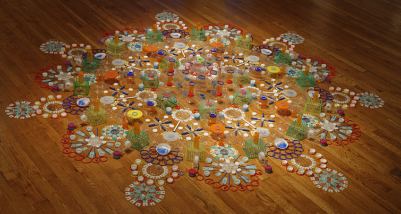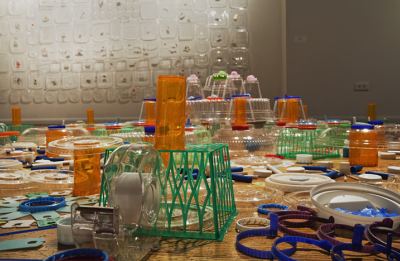Somewhere between Polly Apfelbaum and Pae White is Bradd Skubinna at Francine Seders, with maybe a dog’s left jog over to Richard (Dick) Elliott, whose murals are made of bicycle reflectors.
(Photos Spike Mafford)

 On the floor, Skubinna’s starburst pattern of plastic discards, Gabe Liked Jazz, radiates outward from a meticulously color-coded center. Plastic trays for apples, small appliances, meals to go, light bulbs and muffins inflect a wall with ripples of translucent patterns accented with the remains of torn labeling. A blue screen made of blue New York Times‘ bag wrappers torn to let the light through hangs in the middle of the gallery. Both indoor sky and plastic lace, it sways faintly when the front door opens.
On the floor, Skubinna’s starburst pattern of plastic discards, Gabe Liked Jazz, radiates outward from a meticulously color-coded center. Plastic trays for apples, small appliances, meals to go, light bulbs and muffins inflect a wall with ripples of translucent patterns accented with the remains of torn labeling. A blue screen made of blue New York Times‘ bag wrappers torn to let the light through hangs in the middle of the gallery. Both indoor sky and plastic lace, it sways faintly when the front door opens.



There is something here that I cannot understand. While these displays of recycled objects are fun and interesting to look at, how is it that a gallery can afford to put on a display such as this? Taking stabs at relevance doesn’t pay the light bill, does it?
Funny, thats the same question I ask about the several hundred thousand unsold paintings exhibited every year- how can they afford to show work that they like, if it doesnt sell?
The answer, of course, is that Art is not a sensible business, but a labor of love, and gallery dealers often make the wrong bet, and go broke, or use the profits from, oh, I dont know- something like a $400,000 Deborah Butterfield- to pay for exhibiting work they like, but know will not sell.
I, personally, see a lot of Tony Cragg in this work…
wow, I hope I can make it up north to see this show!
No, this is not a crticism nor opinion as regards to comparisons to paintings etc., but rather a serious question about the allocation of a valuable venue’s floor and wall space to an endeavor that will probably produce little revenue.
Francine Seders is not dumb. She knows her business and she could easily recite off-hand the names of all the Artists who will show at her gallery for the next two years. Her shows are calculated and not without purpose and so I would ask, how would a show of this type make money?
It was noticed by me that the saleable items were placed on the peripheral walls and the recycled montage was placed in the center floor area. This placement was not without forethought.
Nevertheless, I would ask, could there possibly be a buyer for that interesting assemblage on the floor? Would it be picked up en masse and be shipped out and reconstructed on someone’s living room floor? Enlighten me.
Oh yes, whilst we’re on the subject of this show at Francine Seders I’d recommend climbing those stairs to to that little room on the second floor. There is a nice little conceptual interplay between drawing and broken spherical shards going on that I particularly enjoyed. As I myself will often preceed a painting with a preliminary drawing, so too I found myself wondering over the modus operandi employed here. What came first? The chicken or the egg/the drawing or the sculpture? Embarrassed I am to say that I relied upon creaking memory and now I’ve forgotten this Artist’s name. Forgive me.
Ken, you painting prejudice is showing again.
OF COURSE work like this can sell, and often does.
The artist I mentioned before, Tony Cragg, has sold “recycled montages” for more than 10, or maybe 20 paintings sell for at Francine Seders.
As have at least a couple dozen other artists, including people like Sarah Sze, who sold a huge one to the Opera House down at the Seattle Center.
Taking stabs at relevance can pay the light bill in any medium- Andy Goldsworthy does it by arranging leaves and rocks.
Francine believed in this work, so she showed it. She may never see a dime from it, or she may have discovered the next Duchamp. Only time will tell, but it seems to me that you need to widen your horizons a bit, as to what constitutes salable art- artists have sold ice, raw meat, plastic tarps, rocks, garbage, hair, fried chicken, dirt, old tires, water, and much much more.
Ries—-I was taught that there are no foolish questions, only foolish answers. Nevertheless I have gleened some insight from your response and it is appreciated.
It’s friday evening and I just came from The Northwest Film Forum where there was a Seattle premier showing of a documentary about the minimalist collectors Herb and Dorothy Vogel. The Vogels of course, had a preference in their collecting for the minimalist movement but I cannot imagine anyone who might accuse Herb Vogel of being predjudiced against other types of visual art.
True, I do have a preference for pictures. It’s what I do, I make pictures, but that doesn’t preclude me frome enjoying other things that people make. I did enjoy looking at that assemblage on the floor which was reminiscent in its design approach to some of the sand painting I have seen.
By the way Ries, you should stop by and take a look at this show and stop in upstairs and take a look at those shards in that little room. Tell me what you think.
I can see why these remind you of Tony Cragg, but at the same time, the organization of the materials is very different. Cragg used bits of colored plastic of varying sizes to fill a silhouette of a shape, where Skubinna is using the plastic objects themselves to create mandala patterns, which remind me of the sand mandalas created by the Buddhist Monks, temporary art that is meditative and compelling